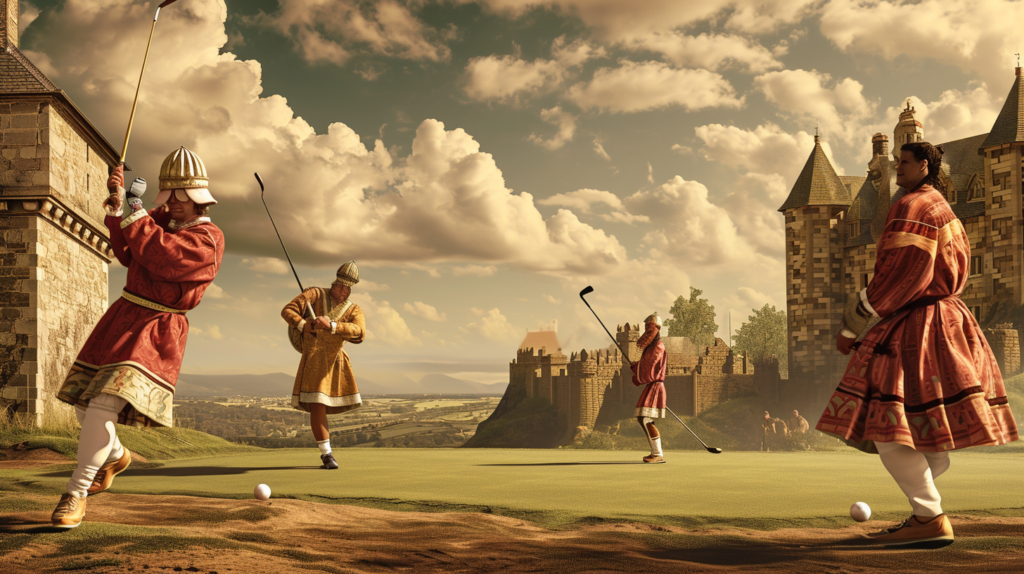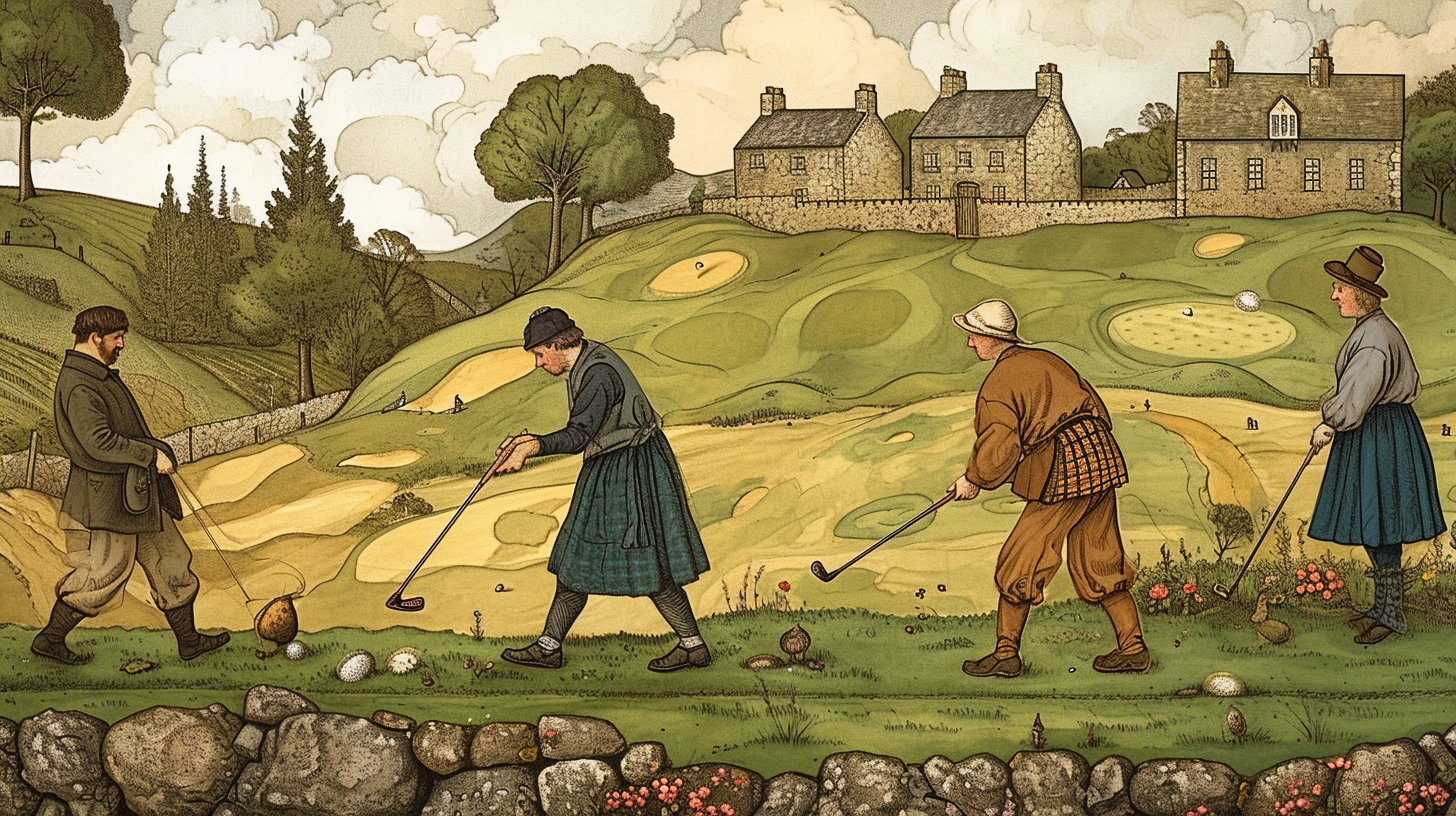Golfers hit little white balls into tiny holes — but how, when and where did this peculiar pastime originate?
Golf has an extensive history spanning over five centuries that saw it transform from informal stick-and-ball games played in Scotland to the highly standardized sport cherished by millions across the world today.
Let’s dive into the major milestones covering golf’s origins, early rule codification, equipment evolution, course architectural advances and eventual worldwide fame.
Origins Of Golf

Golf has ancient origins, tracing back to games played in open meadows and commons in Europe many centuries ago. There is evidence that the Romans played a similar game to golf, involving striking a ball with a stick bent at one end to propel it forward.
As the Roman Empire spread throughout Europe over hundreds of years, conquering new territories and expanding trade routes, this early predecessor to golf likely spread with it.
While these ancient Roman stick-and-ball games share some modest commonalities with the modern sport of golf as it is recognized today, they were more simple pastimes for amusement and not structured sporting endeavors.
The direct ancestry linking those Roman ball games to the codified golf played around the world now is not completely clear.
The modern game of golf emerged in 15th century Scotland along the eastern coast.
Scotland proved to be ideal landscapes for incubating the game of golf during this era, with open and treeless coastal linkslands made up of undulating sand dunes and wide grassy fairways perfect for striking balls across country towards holes dug into the ground.
Scotland is rightly considered the ‘Home of Golf’, with the game blossoming there through the Middle Ages before eventually spreading across the world over successive centuries.
There are sporadic early historical mentions of golf-like ball and stick games being played in other European regions such as the Netherlands and France in the late Middle Ages period around the 14th and 15th centuries.
However it was in Scotland that the concept of golf truly started to resemble the formatted multi-hole journey across long courses that defines the game everyone is familiar with today.
Instead of improvised games played in arbitrary open fields, Scottish golf saw players thoughtfully progressing across coastal meadowlands and parklands explicitly intended for golf play.
Moving hole by hole towards the finals holes strategically set nearer town edges using specialized golf clubs to strike balls into the holes.
So while golf shares ancient ancestral lineage with other stick-and-ball sports, it was in medieval Scotland that golf became golf as we know it today – a scenic multi-hole journey with deliberate shotmaking skills using specialized equipment.
The standardization of rules, equipment, and course design in Scotland fueled golf’s growth locally and set the framework for global expansion in the centuries after its origins.
Standardization Of Rules

Golf began as a casual leisurely pastime, with no formally defined rules or equipment guidelines in its earliest beginnings. Groups of players would organize matches amongst themselves for entertainment and friendly wagering.
The format of play, scoring systems, golf club types used and other regulations often varied from town to town across Scotland’s courses.
But as interest and participation in golf grew, the need emerged for establishing a consistent and fair set of rules to play by, as well as specifications for golf club and ball designs permitted.
To meet this need for unifying golf play parameters, the Honourable Company of Edinburgh Golfers was formed in 1744 and based at Leith Links. This organization can rightly be considered the first official golf club in the world.
Its members were pivotal in turning golf from a decentralized informal pastime into an organized sport governed by a central authority with formally defined rules.
One of their most critical contributions to codifying the game of golf was the publication of the first ever set of 13 Rules of Golf in 1754. This document covered basic parameters for shotmaking, scoring, teeing ground use, hole dimensions, indentifying balls, and more.
By releasing these standardized Rules of Golf for adoption beyond just regional play in Scotland, the Honourable Company of Edinburgh Golfers enabled the game to be played more uniformly across different courses spanning large geographical areas.
Golfers could participate fairly in matches together despite learning the game and honing techniques on wholly separate land and under different past clubs.
The rules also maintained enough flexibility for some variation between individual golf holes, courses, and regions – preserving uniqueness of the playing experience golfers had between say, coastal dune-dotted links versus inland heath, parkland, downland or moorland layouts.
But overall, having an authoritative rules code allowed golf to achieve the consistency required for broader expansion domestically and abroad.
These pioneering golf clubs like the Honourable Company of Edinburgh Golfers contributed enormously to golf history by taking the reigns of codifying and governing the sport during its pivotal early days.
Their early stewardship of standardizing equipment regulations and gameplay rules across Scotland was fundamental to coalescing golf into a structured sport that could then spread as a unified concept across continents.
Golf owes its firm identity to these inaugural rulemaking clubs.
Evolution Of Golf Clubs And Courses

In golf’s earliest known beginnings, equipment was quite primitive and minimal.
Golf clubs were handcrafted from wood, balls were improvised from random available materials, and “courses” simply made use of existing open parklands or coastal linkslands with holes dug into turf by the players themselves.
But as interest and participation in golf as a competitive sport grew over 18th and 19th century Scotland, demand grew concurrently for improved equipment and professionally designed golf courses to properly play the game on as it further developed.
The featherie golf ball stuffed tightly with boiled goose or chicken feathers encased in stitched cowhide began use starting in the early 17th century.
The featherie required painstaking hand-assembly production by trained ball makers and was quite sensitive to moisture, but allowed for great distances compared to earlier compacted leather pouches when struck purely.
Specialized wood-headed clubs were crafted to best compress featheries and propel them across early Scottish courses. Featherie longevity helped spur course expansion too.
In 1848, the gutta-percha ball was created from dried sap of Malaysian sapodilla trees as the first mass produced recreational ball for golf and other stick-and-ball sports.
Gutta-percha balls were cheaper with more uniform sphericity than featheries and improved durability against course hazards, lending itself well as golf play moved inland away from coastal dune links across Scotland and England.
Their adoption coincided fortuitously with the Victorian Era golf boom of the mid-19th century. The reliable gutta held shape in varying weather and temperate inland grasslands encountered by an increasingly mobile golfing society.
Just as golf ball materials advanced from feather-stuffed leather orbs to imported tree resin, golf club innovation also continued into the 20th century transitioning from traditional wood bodies to stronger compressed paper mache forms with forged steel clubheads.
Newly developed carbon steel clubheads afforded greater density and rigidity for power and accuracy. Customizable weight distribution and clubface angles also helped golfers optimize performance for different kinds of shots and course challenges encountered.
Early golf courses were simply existing links pasturelands in Scotland and England with holes pre-dug into the ground where golfers finished their route.
But as participation grew domestically and abroad, dedicated investments were made into intentionally designing and shaping landscapes to serve as specialized golf courses instead of just minimally repurposed grazing land.
Architectural additions like integrated sand bunkers, water hazards, multilevel greens and fairway elevation contouring served to enhance strategic challenges for golfers.
Over the decades both on venerable British Isles courses as well as thousands of export golf developments globally.
Many legendary courses golfers around aspire to play today like the Old Course at St Andrews that retain links land pedigree were still open parkland into the 1800s.
But even courses like St Andrews underwent intentional alterations and improvements over successive decades to strengthen them as rigorous, respected tests of golf skill while preserving their historical prints.
Great responsibility rests with golf architects on balancing that strategic modernization while maintaining the authentic spirit linked to iconic golf courses tied to the game’s origins story.
Rise Of Golf As A Global Sport

Golf retained its reputation as largely a Scottish and English leisurely pastime through the 17th and 18th centuries after its codification in Scotland.
But as both Scotland and England’s global military, trade and political influence swelled enormously over the 19th century amid the British Empire era, golf incrementally gained a larger international footprint too piggybacking on British colonialism and foreign occupation.
As Scottish regiments and British armed forces more broadly expanded across continents to safeguard foreign interests and expand territorial control, they brought golf with them overseas.
British military officers and civil administrators dispatched to imperial holdings like India, South Africa, Australia, New Zealand, Canada and elsewhere stoked interest in practicing golf recreationally and competitively abroad to retain sporting ties and nostalgia for home.
These colonials founded local golf clubs and courses modeled on archetypal British and Scottish Links templates, importing clubs and balls to uphold proper playing conditions.
British sports like cricket, tennis, football, polo and of course golf became staples of British expatriate life embedding western leisure habits across swaths of shaped occupied lands. Golf’s global spread tracks very closely with the ebbs and flows of British imperialism over 200 years.
This expansionist pattern lead ultimately to golf putting down stakes across the Atlantic, as waves of primarily Scottish and English immigrants looked west in the 1890-1920 period.
While much migration fever was fueled by aspirations for prosperity and land ownership, British emigrants also yearned to foster community through familiar social institutions and pastimes in their new settlements.
There was great early enthusiasm for founding golf clubs modeled after legendaryScottish ones and building scenic courses to cater to everyone from American urban elites seeking new leisure activities as well as rural farmers enjoying a shared hobby during weekends off work.
The late 1800s United States golf boom parallelled soaring industrialization, immigration spikes, and growing middle class disposable income that allowed working citizens leisure time and funds to explore golf as a new activity.
Golf course construction flourished everywhere from burgeoning metropolises to small rural towns as population and wealth demographics nurtured golf interest.
American banking and industrial fortunes sponsored some prominent courses too but public municipal designs also stoked interest from masses.
As golf’s global reach broadened through mercantile, military and social channels over the early 20th century.
Increasingly structured competition frameworks emerged in the form of national opens, international tournaments, interstate championships and ultimately multinational professional player tours to unify golf interest across borders.
Golf also boasted a celebrated Olympic history as a medal sport early in the modern Olympic era returning from a long hiatus as a headlining event at the 2016 Rio Olympic Games.
Punctuating the culmination of its multinational mass appeal after centuries spreading outbound from Scotland.
Conclusion
From humble beginnings on Scotland’s historic linkslands, golf has undertaken a remarkable centuries-long journey to emerge as one of the world’s most beloved and widely-played sports.
Though its exact inception is unknown, it was the standardization of golf’s rules and equipment in 18th century Scotland that set the stage for the game’s expansion within and beyond Britain.
Thanks to golf’s export via military and trade channels, what was once a casual Scottish pastime is now a global sport woven into the social fabric across continents. Wherever golf spreads next, it will carry with it the indelible spirit and lore of Scotland, the homeland of golf.



